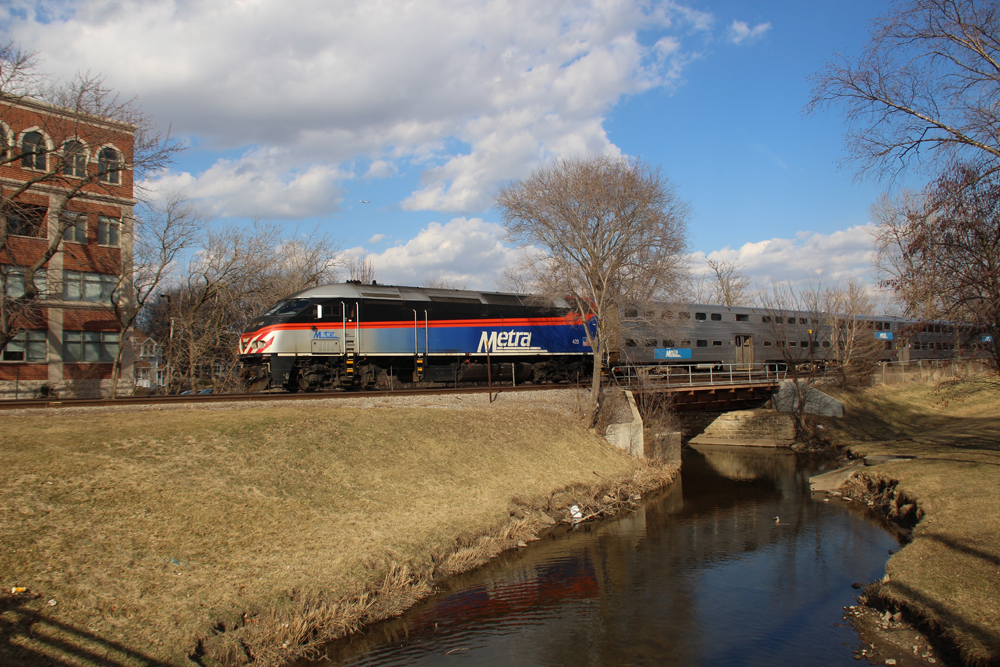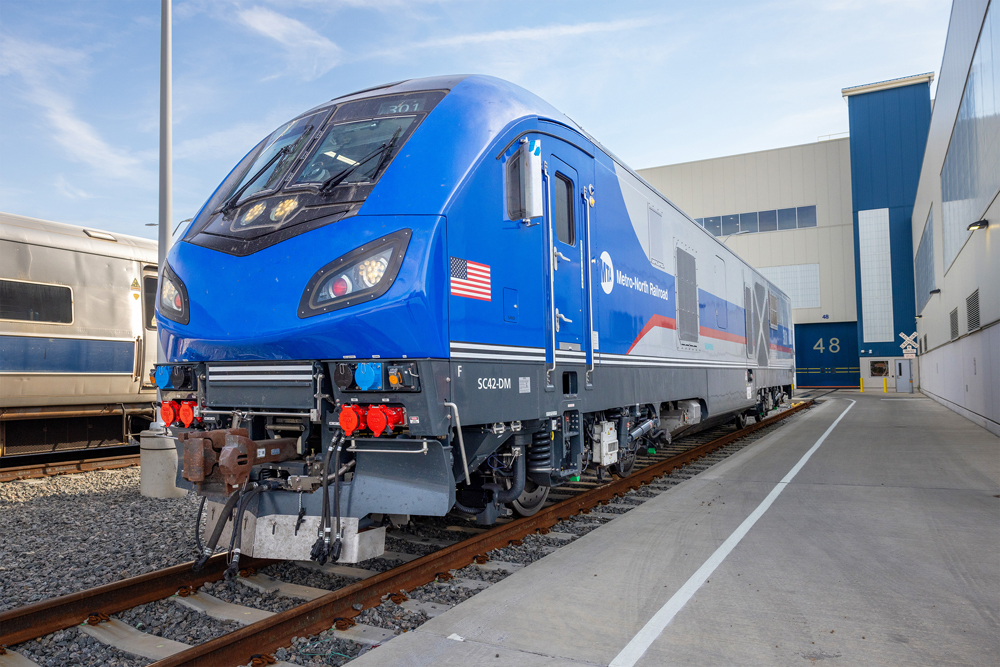
SPRINGFIELD, Ill. — An Illinois lawmaker has introduced legislation opposing the Canadian Pacific-Kansas City Southern merger, saying the merger’s projected traffic increases “presents far too many risks” to lineside communities.
State Rep. Anna Moeller (D-Elgin) represents one of the eight communities in the Coalition to Stop CPKC. Those communities, along the Metra Milwaukee West route shared with CP freight traffic, want to block the deal based on the merger application’s projection that the route will see an increase from three to 10 freight trains daily. If the merger is approved, they are asking for more than $9 billion in mitigation projects — more than the entire price tag for the 70-project CREATE program in the Chicago area [see “Chicago suburbs seek $9.5 billion …,” Trains News Wire, March 1, 2022].
The Daily Herald reports Moeller, a Democrat, filed House Resolution 773 in opposition to the merger; its 10 co-sponsors include eight Democrats and two Republicans.
“Rail transportation is an important part of our economy, but we have to balance it with keeping our communities safe and ensuring traffic can flow freely,” Moeller wrote in a press release. “…I am proud to stand with a bipartisan group of my colleagues from the affected suburban communities we represent to send a strong message of opposition to this proposal.”














10 freights a day? Are you serious? That’s not a lot.
It is SO hard to deal with the gross stupidity of too many politicians.
Yes, in theory. But elections are too infrequent to matter.
All valid points. But on other posts, some of the same posters lambast the RR industry for PSR and abusing their workers. The longer trains of PSR when they get held up block many more crossings then days of old. While the requests by these suburbs seems outrageous, they are further signs that policy makers believe their constituents are getting fed up with the railroads inconveniencing their lives. If the RR continue on their path of service breakdown, continuing to increase congestion in communites and their treatment of employees, they are just begging for increased regulation!!!
There is a minority belief that in fact the railroads want to be regulated again. The drive to lower their ratio with no regulatory basement to fall on has made the Class 1’s (quietly) clamor for the days where they could “soft” compete using lobbyists to mend the competitive frays.
But with deregulation going on 40+ years, Wall Street began to notice that railroad leadership wasn’t about competition, it was about optimizing margins, so they used their financial muscle to force it to go farther than ever done before.
So the “competition” wasn’t really about providing best service, it became providing the best investment to hedge and leverage. This caused a shift of profits, not to be used for capital improvements, but to be used for stock buybacks to reward their “investment”.
BNSF was smart to go private, with no stock to have external forces on Wall Street pushing them from behind, they were left free to plan their capital strategies differently. The only external pressure they faced was the right kind, from the UPRR.
Despite the distance I can hear the collective guffaw from the STB.
That said there is the bigger issue: money. Specifically money for basic improvements such as highway overpasses. The roadway well has run dry and the congress-critters are more than well aware of this new reality. Hence the asinine moves such as this to grab money, ANY money, to plug the growing budget gaps in transportation. This desperation will only grow during this decade.
Isn’t there something abt railroads being a Federal issue? I would think (maybe, I’m not so sure abt. her level of intelligence) that she knows this & as said above, is a publicity stunt for the next cycle of elections.
I wonder what would happen to the Illinois economy if all railroads (From Class I to industrials) simply pulled-up their tracks, never to return? Businesses shouldn’t stay where they’re unwelcome.
The next round of transcontinental mergers might accomplish a lot in bypassing Chicago and the slow, painful interchange process. Maybe not pull up tracks but it would certainly make it a lot easier to reconfigure crew points and simply run trains through Chicago and Illinois in general
Fortunately you don’t need a round of transcon mergers to get a Chicago Bypass to work. You just need 6 Class 1’s to agree to interchange somewhere else.
They prefer Chicago because its cheap and “everyone” is there or in the area nearby. Chicago has access to the US both east and west and to Canada and Mexico. To try and build and support other means of interchange on the something close in scale would cost a lot of money, money Wall Street does not want them spending.
If CN and CP can’t even agree on how to interchange a trivial 30-45 cars a day @ Spaulding do you think the rest would simply fall in line instantly? Hardly.
How many attempts have been made over the years to try and get a Chicago bypass in place? The Peoria Gateway? East St Louis? Memphis?
While having everyone meet in Chicago appears to be the most cost effective, to me it carries a large degree of logistics risk. If Chicago has a service meltdown, a terrorist event or act of God event, do you think the Class 1’s have a healthy plan to maintain service?
We stress test financial institutions all the time, when did the FRA stress test the Class 1’s? What if we took Chicago “virtually” offline for 24 hours, what would they do? How would they do? (My guess, is pretty bad)
JOHN — Many good points in your post (above). Sooner or later Chicago will melt down. Much as I have enjoyed watching big BNSF and NS merchandise freights interchanging at Cicero — Chicago, I have to ask myself, does this urban, passenger-heavy route make any sense? Why isn’t this freight routed through something reasonable like Kankakee? Or Joliet to Porter via the former Michigan Central which is now a bike path. Why didn’t ATSF stick with TPW into Indiana instead of off-loading it?
All through the 1970’s and 1980’s we kept reading about “redundant” rail routes and “corridors of excess capacity”. Some of them could have been improved for a Chicago bypass. Instead of abandoned or else spun off to cornfield short lines.
“Why didn’t ATSF stick with TPW into Indiana instead of off-loading it?”
Easy, because no one would interchange with ATSF this way. A container yard was even built in Remington Indiana to support the traffic. Now its used for storage. ATSF offered it, it had no takers.
Why didn’t UP route California fruit via East St Louis? They tried (once) and it was too low in volume (not enough interchange with CSX and a drought) so they routed all the reefers via Chicago instead and added 2 days to the trip making it uneconomic. The service was cancelled.
Remember those entrepreneurs who saw the same issue in Chicago and tried to start a new Chicago bypass that passed through where the new freight airport is going to be? Before they even had funding, UP, BNSF, CN and CSX said they wouldn’t use it. Even though several models showed it could decrease coal drags and container “pass throughs” by a day at the least, they wanted nothing to do with it.
So unless a jointly owned entity like IHB or BRC wants to do something, it just won’t happen. It’s the strangest use of capital I have ever seen. If you spent capital to realize a cost savings and higher efficiency that would pay off for the next 30-40 years isn’t that worth it? the Class 1’s say there isn’t.
Can anyone say “political stunt?”
I knew you could.
Is she serious? an increase of 3-10 trains will cause catastrophic consequences?
The main thing I would want to know is: how many places are there within the suburban district, where a long train could stop and not block crossings while waiting to get into its yard? The rest of this, to me, seems to be fishing for “free” money for community improvements.
While were at it, let’s limit the amount of highway traffic that can go on the Illinois expressways too…after all, if it gets too crowded, it would create a dangerous traffic hazard. (sarcasm intended)
Wonderful idea, particularly when fewer freight trains = more truck traffic!!!! If it only takes a mere $9 billion of private sector money to mitigate 7 additional trains/day through these communities, then it should only cost these communities another, say, $40-$60 billion in local government funds to mitigate the corresponding increased highway traffic caused by limiting train traffic (sarcasm also intended).
As you can see, stupidity is bipartisan here in Illinois.
As in most State Legislatures. I won’t get into it on the Federal level.
Anna Moeller is a pretty level headed Representative who is a bit above her head on this one. My guess is she just jumped into it without learning the history of this line or how the towns sprung up along the line because of the railroad. Already wrote to her this morning asking her to do more homework so she doesn’t look like somebody’s fool. Including how the towns and city of Elgin justify $7 Billion.
Traffic must flow free…just not next to me….
Would love to be on the House Floor if/when the legislation comes up for a vote.
See if Rep. Moeller can answer any questions about CP-KCS operating plan in her district, and why it would cost $7 billion to make it work.
NIMBYism appears to be strong in IL. I assume if the state would pass a bill to stop the merger its main effect would be to apply political pressure on the Biden administration to turn it down.
For a wnderful example of a politician’s Double Plus Ungood Duckspeak, read the last paragraph of the article above.